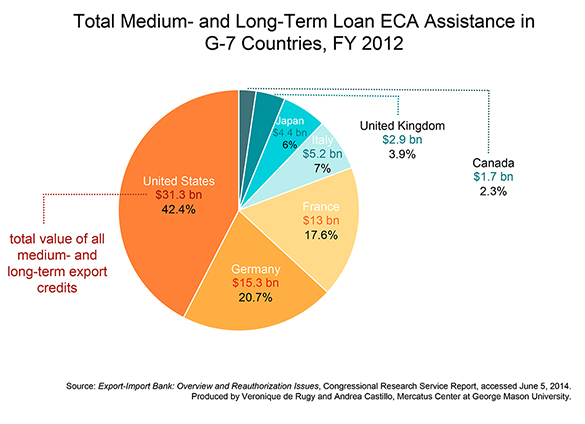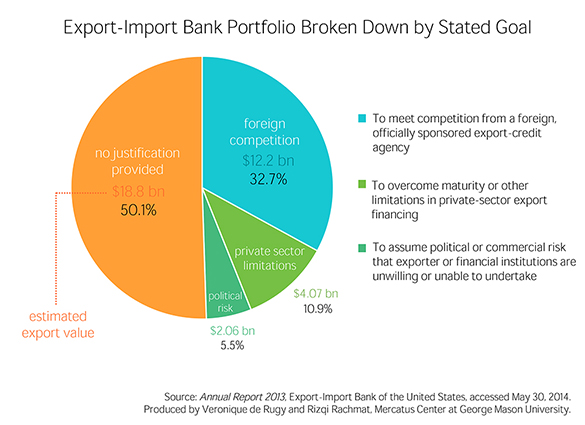- | Government Spending Government Spending
- | Data Visualizations Data Visualizations
- |
Key Argument for Export-Import Bank Invalid
Less Than One-Third of Bank’s Activities Offsets Foreign Export Subsidies
This week’s charts use data from the Export-Import Bank’s Annual Report 2013 and from a new Congressional Research Service (CRS) report on the Export-Import Bank. They show that while a small proportion of the Ex-Im Bank’s work is dedicated to counteracting foreign government export subsidies, the US government is actually one of the worst offenders when it comes to subsidizing domestic exports.
Supporters of the Export-Import Bank (Ex-Im Bank) argue that the federal government must subsidize American exports to "level the playing field” with foreign competitors who receive subsidies from their governments.
This week’s charts use data from the Export-Import Bank’s Annual Report 2013 and from a new Congressional Research Service (CRS) report on the Export-Import Bank. They show that while a small proportion of the Ex-Im Bank’s work is dedicated to counteracting foreign government export subsidies, the US government is actually one of the worst offenders when it comes to subsidizing domestic exports.
The first chart shows that less than one-third of the bank’s activities in Fiscal Year (FY) 2013 were dedicated to countering subsidized foreign competition. The second chart compares US government-backed export credit amounts for medium- and long-term loans to other G-7 nations for FY 2012.
For a long time, the bank did not specify the exact purpose of all of its financial transactions in its reports, so determining how much of its portfolio was dedicated to which goals was a guessing game. As recently as 2012, economist Sallie James of the Cato Institute speculated, “Given the fall in export credit subsidies in the OECD, the need for countervailing activities likely has not increased since the late 1990s, when less than 20 percent of Ex-Im guarantees and insurance were for the purpose of countering officially supported foreign competition.”
However, as a condition of its most recent reauthorization in 2012, Congress required the Ex-Im Bank to provide more explanation for certain portfolio transactions. While the bank still does not provide justifications for all transactions in its portfolio, its current charter compels it to provide at least some explanation by category for all loans and long-term loan guarantees in its annual report. These transactions must be classified in one of three categories: 1) “to assume political or commercial risk that exporter and/or financial institutions are unwilling or unable to undertake”; 2) “to overcome maturity or other limitations in private-sector export financing”; or 3) “to meet competition from a foreign, officially sponsored export-credit agency.”
The first chart displays these data: $4.1 billion in estimated export value for loans and guarantees is justified in the bank’s Annual Report as necessary to counteract “political risks,” which is represented in dark green. The Ex-Im Bank reports that $2.1 billion in estimated export value for loans and guarantees is to address “private sector limitations,” as represented in light green. Finally, the bank justifies $12.2 billion in estimated export value for loans and guarantees is to meet “foreign competition.” The proper categories for the remaining $18.8 billion in estimated export value—more than half of the Ex-Im Bank’s remaining transactions—are simply unknown and represented in orange.
The estimated export value of the bank’s entire portfolio for FY 2013 was roughly $37 billion. Thus, less than one-third of the bank’s financing is claimed to counteract competitive disadvantages wrought by foreign export credit agencies.
What’s more, much of this financing goes to large corporations that are unlikely to need it to compete effectively in the global marketplace. For instance, roughly 66 percent of the value designated to “meet competition from a foreign, officially sponsored export-credit agency” went to the Boeing Corporation, whose own financial director publicly admitted that they could “find alternative funding sources” without Ex-Im Bank.
 The second chart uses data from a CRS report released on June 3, 2014 (“Export-Import Bank: Overview and Reauthorization Issues”) that summarize the total export assistance that each G-7 nation provided through government export credits in 2012. We formatted the report’s data from its appendix dataset listing the total amount of government-backed export credit assistance to medium- and long-term projects for major international exporters.
The second chart uses data from a CRS report released on June 3, 2014 (“Export-Import Bank: Overview and Reauthorization Issues”) that summarize the total export assistance that each G-7 nation provided through government export credits in 2012. We formatted the report’s data from its appendix dataset listing the total amount of government-backed export credit assistance to medium- and long-term projects for major international exporters.
The chart shows that the United States is the clear leader of the G-7 Export Credit Agency pack, dispensing $31.3 billion in 2012, or 42.4 percent of the total $73.9 billion for all G-7 nations that year. The second place export-subsidizer, Germany, doled out $15.3 billion—less than half the value of US subsidies. After France’s slightly more modest $13 billion, Italy, Japan, the United Kingdom, and Canada spent less than $6 billion each.
This chart shows that the United States is far from a victim in the world of export credit subsidies.
Together, these charts suggest that support for the Ex-Im Bank on the grounds that it effectively counters foreign subsidies is misguided at best. The bank backs less than two percent of the value of total US exports, which means that more than 98 percent of US exports compete effectively in the global market without any such assistance. In addition, the bank’s data show that it justifies less than one-third of this tiny portion of exports on the grounds of countering foreign government subsidies. In other words, the Ex-Im Bank itself only claims to counteract less than one percent of the value of US exports that are exposed to foreign-subsidized competition.
The United States committed a whopping $31.3 billion in export credits in 2012, while Japan and the United Kingdom still manage to maintain healthy exports with only $4.4 billion and $2.9 billion in respective assistance.
While the bank’s effect in countering foreign subsidies is negligible, its activities come at the great costs of corporate cronyism and irresponsible use of taxpayers’ money. It’s time to retire the Ex-Im Bank.
Note: An accompanying chart and dataset of CRS data on non-OECD nations like China, India, and Brazil can be found in the attached dataset. The data show that only China exceeded the US in ECA assistance during FY 2012, with a reported $45 billion for that year. Data on ECA assistance by population, GDP, and national export value can also be found in the dataset above.


